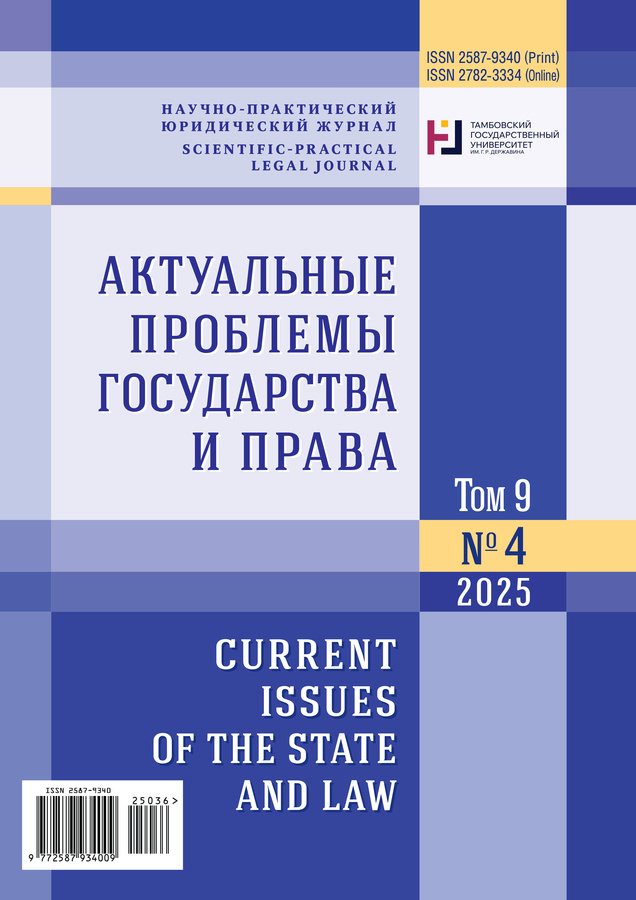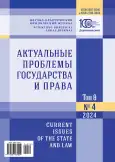Публично-правовое регулирование биомедицинских технологий: опыт Норвегии
- Авторы: РОМАНОВСКИЙ Г.Б.1, РОМАНОВСКАЯ Е.А.1, ДАСАЕВА А.И.1
-
Учреждения:
- ФГБОУ ВО «Пензенский государственный университет»
- Выпуск: Том 8, № 4 (2024)
- Страницы: 530-537
- Раздел: Проблемы частного и публичного права
- URL: https://journal-vniispk.ru/2587-9340/article/view/303579
- ID: 303579
Цитировать
Полный текст
Аннотация
Проведено компаративистское исследование правового регулирования биомедицинских технологий. Цель исследования заключается в правовом изучении опыта Норвегии, представляющего собой пример консервативного подхода, основанного на максимально осторожном разрешении инноваций в столь чувствительной сфере. Подробно проанализированы основные положения Закона от 5 декабря 2003 г. № 100 «О медицинском использовании биотехнологий и т. д. (Закон о биотехнологии)». Этот закон исходит из соблюдения универсальных принципов в биомедицине – уважения человеческого достоинства, соблюдения прав человека и личной неприкосновенности, недискриминации по признаку наследственности, продвижения принципов биоэтики. Показаны основные ограничения, которые налагаются на медицинских работников при реализации вспомогательных репродуктивных технологий. Так, Норвегия – страна, где запрещено суррогатное материнство, а рождение детей с помощью вспомогательной репродукции возможно только после тщательной проверки пары на предмет возможности воспитания ребенка в надлежащих условиях. Предъявляются специальные требования к получению согласия на использование различных биологических объектов (ткани, клетки человека, абортированный материал) в исследовательских целях. Выделено, что действует специальное законодательство, определяющее правовой режим биобанков. Сделан вывод, что наличие жестких правил коррелируется с уровнем высокого доверия к системе общественного здравоохранения.
Ключевые слова
Об авторах
Георгий Борисович РОМАНОВСКИЙ
ФГБОУ ВО «Пензенский государственный университет»
Автор, ответственный за переписку.
Email: vlad93@Sura.Ru
ORCID iD: 0000-0003-0546-2557
Scopus Author ID: 57191983029
ResearcherId: S-7012-2016
доктор юридических наук, профессор, заведующий кафедрой «Уголовное право»
Россия, Российская Федерация, 440026, г. Пенза, ул. Красная, 40Екатерина Андреевна РОМАНОВСКАЯ
ФГБОУ ВО «Пензенский государственный университет»
Email: up406@mail.ru
ORCID iD: 0009-0007-3040-083X
инженер-исследователь кафедры «Уголовное право»
Россия, Российская Федерация, 440026, г. Пенза, ул. Красная, 40Анастасия Исмаиловна ДАСАЕВА
ФГБОУ ВО «Пензенский государственный университет»
Email: nastya.dasaewa@yandex.ru
ORCID iD: 0009-0004-6314-1297
инженер-исследователь кафедры «Уголовное право»
Россия, Российская Федерация, 440026, г. Пенза, ул. Красная, 40Список литературы
- Brunner H.G., Nelen M., Breakefield X.O., Ropers H.H., van Oost B.A. Abnormal behavior associated with a point mutation in the structural gene for monoamine oxidase A // Science. 1993. Vol. 262. № 5133. Р. 578-580. https://doi.org/10.1126/science.8211186
- McDermott R., Tingley D., Cowden J., Frazzetto G., Johnson D.D.P. Monoamine oxidase A gene (MAOA) predicts behavioral aggression following provocation // Proceedings of the National Academy of Sciences of the United States of America. 2009. Vol. 106. № 7. Р. 2118-2123. https://doi.org/10.1073/pnas.0808376106
- Bhoi S., Sarangi P., Pradhan L.K., Sahoo P.K., Sahoo B.S., Aparna S., Raut S., Das S.K. Bisphenol F-induced precocious genesis of aggressive neurobehavioral response is associated with heightened monoamine oxidase activity and neurodegeneration in zebrafish brain // Neurotoxicology and Teratology. 2024. Vol. 106. Art. 107402. https://doi.org/10.1016/j.ntt.2024.107402
- Зоричева А.С., Звонова Е.А., Агапова Л.С., Лыкова М.С., Маркова О.А., Леонов В.С. Опыт производства и клинического применения биомедицинского клеточного продукта Изитенс® для восстановления повреждений хрящевой ткани коленного сустава человека // БИОпрепараты. Профилактика, диагностика, лечение. 2024. Т. 24. № 2. С. 172-187. https://doi.org/10.30895/2221-996X-2024-24-2-172-187, https://elibrary.ru/oosrku
- Sundby J. Infertility in public health: the case of Norway // Facts, Views & Vision in ObGyn. 2010. Vol. 2. № 3. Р. 177-181.
- Романовская О.В. Генетическое консультирование в семейном праве // Гражданин и право. 2014. № 12. С. 71-80. https://elibrary.ru/tctfvx
- Goisis A., Håberg S.E., Hanevik H.I., Magnus M.C., Kravdal Ø. The demographics of assisted reproductive technology births in a Nordic country // Human Reproduction. 2020. № 35 (6). Р. 1441-1450. https://doi.org/10.1093/humrep/deaa055
- Johannessen J., Nærland T., Hope S., Torske T., Høyland A.L., Strohmaier J., Heiberg A., Rietschel М., Djurovic S., Andreassen Ole A., Butler Merlin G. Parents’ Attitudes toward clinical genetic testing for autism spectrum disorder – data from a Norwegian sample // International Journal of Molecular Sciences. 2017. Vol. 18. № 5. Art. 1078. https://doi.org/10.3390/ijms18051078
- Von Krogh A.S., Waage A., Quist-Paulsen P. Kongenital trombotisk trombocytopenisk purpura // Tidsskr Nor Legeforen. 2016. № 136. Р. 1452-1457. https://doi.org/10.4045/tidsskr.15.1272
- Prescott Т. Skal friske barn testes for genetisk sykdomsdisposisjon? // Tidsskr Nor Legeforen. 2016. № 136. Р. 1421.
- Экономическое право / под науч. ред. Н.С. Бондаря. М.: Проспект, 2021. 352 с. https://doi.org/ 10.31085/9785392336791-2021-352, https://elibrary.ru/iymonq
Дополнительные файлы










